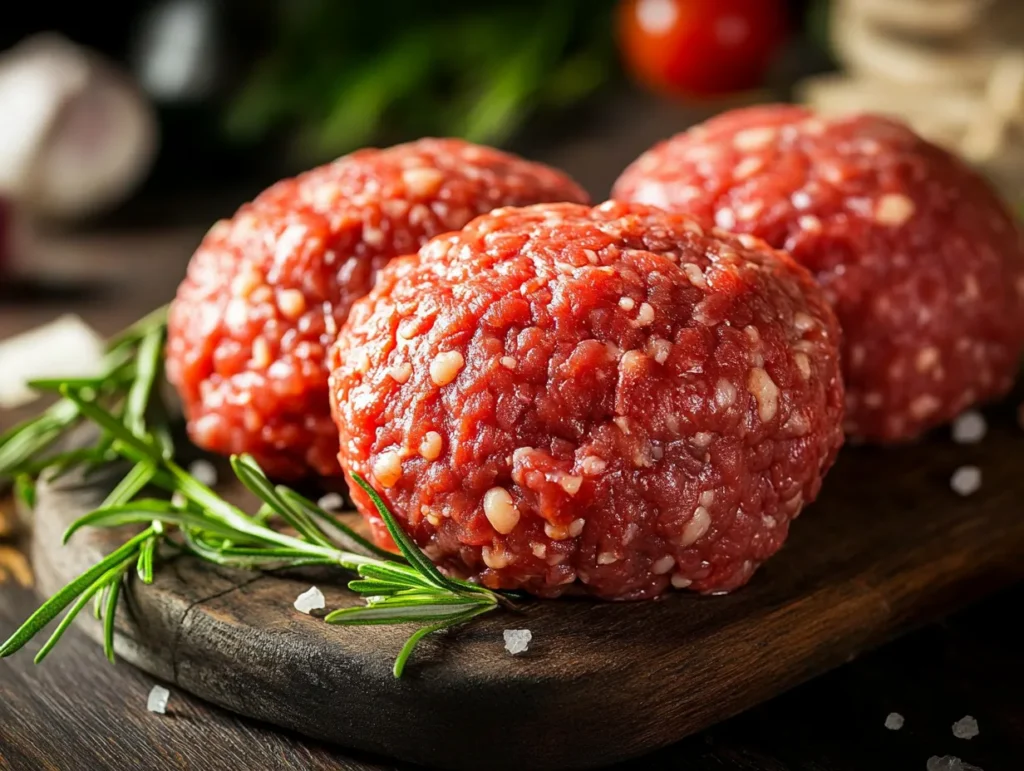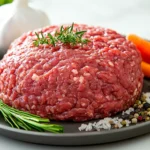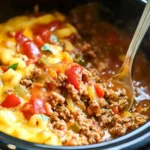Ground beef is one of the most versatile and widely consumed meats, and among the various blends available, 80/20 ground beef is a favorite. The numbers refer to the lean-to-fat ratio, meaning 80% of the weight comes from lean meat while 20% comes from fat. This blend is known for its rich flavor, juiciness, and ability to stay moist during cooking.
But beyond taste and texture, how does 80/20 ground beef nutrition compare to other blends? Is it healthy? What are the best ways to prepare it while maintaining its nutritional benefits? This article will explore everything you need to know about 80/20 ground beef nutrition, its pros and cons, and how to incorporate it into a balanced diet.
Nutritional Profile of 80/20 Ground Beef
When considering 80/20 ground beef nutrition, it’s important to look at its macronutrient composition, vitamin and mineral content, and how it compares to other protein sources. The balance of protein and fat in this beef blend makes it a preferred choice for various dishes, especially where flavor and juiciness matter.
Calories and Macronutrients
The nutritional content of 80/20 ground beef can vary slightly based on cooking methods, but here’s a general breakdown per 100 grams (3.5 ounces) of raw 80/20 ground beef:
- Calories: ~250 kcal
- Protein: ~17 grams
- Total Fat: ~20 grams
- Saturated Fat: ~8 grams
- Monounsaturated Fat: ~9 grams
- Polyunsaturated Fat: ~1 gram
- Cholesterol: ~70 mg
After cooking, some fat is lost, meaning the calorie and fat content may decrease slightly, depending on the cooking method.
Vitamins and Minerals in 80/20 Ground Beef

80/20 ground beef is a rich source of essential micronutrients, including:
- Iron (~2.5 mg per 100g) – Supports oxygen transport in the blood.
- Zinc (~4.5 mg per 100g) – Crucial for immune function and wound healing.
- B Vitamins
- Vitamin B12 (~2.5 mcg per 100g) – Essential for red blood cell formation and brain health.
- Niacin (B3) (~4.5 mg per 100g) – Aids in energy metabolism.
- Vitamin B6 (~0.4 mg per 100g) – Supports brain function and immune health.
- Phosphorus (~180 mg per 100g) – Important for bone health and energy storage.
Protein Content and Benefits
With 17 grams of protein per 100 grams, 80/20 ground beef is an excellent source of high-quality protein. This protein provides all nine essential amino acids, making it a complete protein source that helps:
- Build and repair muscles.
- Maintain satiety and control appetite.
- Support immune function.
Fat Content and Considerations
The 20% fat in 80/20 ground beef contributes to its rich flavor and tenderness. The fat content includes:
- Saturated fat – Can raise LDL (bad) cholesterol but also plays a role in hormone production.
- Monounsaturated fat – Supports heart health when consumed in moderation.
- Polyunsaturated fat – Includes small amounts of omega-3 and omega-6 fatty acids.
Since saturated fat intake should be monitored for heart health, portion control and healthy cooking methods are key when consuming 80/20 ground beef regularly.
Print
80/20 ground beef nutrition
- Total Time: 25 minutes
- Yield: 4 servings 1x
Description
This juicy and flavorful 80/20 ground beef recipe is perfect for making burgers, tacos, meatballs, or pasta sauces. With the right balance of protein and fat, this dish ensures tenderness and rich taste. This guide includes step-by-step cooking instructions, helpful tips, and nutrition details to help you enjoy 80/20 ground beef in a healthy and delicious way!
Ingredients
- 1 lb (450g) 80/20 ground beef
- 1 tsp salt
- ½ tsp black pepper
- ½ tsp garlic powder
- ½ tsp onion powder
- 1 tbsp Worcestershire sauce (optional, for extra flavor)
- 1 tbsp olive oil or butter (for cooking, if needed)
Instructions
Prepare the Beef:
- In a large mixing bowl, combine 80/20 ground beef, salt, black pepper, garlic powder, and onion powder.
- If desired, add Worcestershire sauce for extra umami flavor. Mix gently without overworking the meat.
Shape into Patties or Meatballs:
- If making burgers, divide the beef into 4 equal portions and shape them into patties (about ½ inch thick).
- If making meatballs, roll into 1-inch balls.
Cook the Beef:
- For burgers: Heat a skillet or grill over medium-high heat. Cook patties for 3-4 minutes per side, or until the internal temperature reaches 160°F (71°C).
- For meatballs: Preheat oven to 375°F (190°C). Place meatballs on a lined baking sheet and bake for 18-20 minutes.
Serve & Enjoy:
- Serve on burger buns, lettuce wraps, or with pasta.
- Pair with veggies, cheese, or sauces for extra flavor
Notes
- Do not overmix the beef, as it can make the texture tough.
- For extra juicy burgers, let patties rest for 5 minutes after cooking.
- Use a meat thermometer to ensure beef is fully cooked to a safe internal temperature of 160°F (71°C).
- To reduce fat, drain excess grease from the pan after cooking.
- Prep Time: 10 minutes
- Cook Time: 15 minutes
- Category: Main Course
- Method: Grilling / Pan-Frying / Baking
- Cuisine: American
Nutrition
- Serving Size: 4 oz (113g) cooked
- Calories: ~290 kcal
- Sugar: 0g
- Sodium: ~300 mg
- Fat: ~22g
- Saturated Fat: ~9g
- Unsaturated Fat: ~10g
- Trans Fat: ~0.5g
- Carbohydrates: 0g
- Fiber: 0g
- Protein: ~21g
- Cholesterol: ~75 mg
Keywords: 80/20 ground beef nutrition
Health Benefits of 80/20 Ground Beef
While 80/20 ground beef is often associated with indulgent meals like burgers and meatloaf, it offers several nutritional benefits when consumed as part of a balanced diet.
1. High-Quality Protein for Muscle Growth and Maintenance
Protein is essential for muscle development, repair, and maintenance. Athletes, bodybuilders, and individuals following high-protein diets can benefit from the complete protein found in 80/20 ground beef. The amino acids help with:
- Muscle repair after workouts.
- Preventing muscle loss with aging.
- Keeping you full longer, reducing cravings.
2. Rich Source of Iron for Energy and Blood Health
Iron from red meat is highly bioavailable, meaning the body absorbs it efficiently. The heme iron in ground beef helps prevent iron deficiency anemia, reducing symptoms like fatigue and weakness.
3. Supports Brain and Nervous System Health
80/20 ground beef contains B vitamins, especially B12, which is crucial for:
- Brain function and memory.
- Nerve health and red blood cell production.
- Reducing the risk of cognitive decline.
4. Provides Essential Minerals for Overall Health
Ground beef supplies important minerals such as:
- Zinc – Boosts immune function and supports wound healing.
- Phosphorus – Helps with bone strength and energy production.
5. Supports Hormone Production
Dietary fat is necessary for hormone production, including testosterone and estrogen. The healthy fat balance in 80/20 ground beef helps maintain hormonal balance when eaten in moderation.
Potential Drawbacks of 80/20 Ground Beef
Despite its benefits, 80/20 ground beef nutrition has some potential concerns, particularly regarding saturated fat and cholesterol intake.
1. High in Saturated Fat
With 8 grams of saturated fat per 100 grams, regular consumption of large portions of 80/20 ground beef may contribute to:
- Increased LDL cholesterol levels (which may increase heart disease risk).
- Higher calorie intake, leading to weight gain if not balanced with other nutrients.
🔹 Solution: Opt for leaner cuts occasionally (like 90/10 or 85/15) or use healthy cooking methods (grilling, draining fat, etc.).
2. Higher Calorie Density
Since fat is more calorie-dense than protein, 80/20 ground beef is higher in calories than leaner beef blends. This can make weight management challenging if portion sizes aren’t controlled.
🔹 Solution: Measure portions carefully and pair ground beef with fiber-rich vegetables to balance calorie intake.
3. Processed and Fast-Food Risks
Many popular 80/20 ground beef dishes, like burgers and tacos, are often consumed with processed ingredients (buns, fries, cheese, sauces). This can lead to:
- Excess sodium intake.
- More unhealthy fats from processed foods.
- Higher overall calorie intake.
🔹 Solution: Cook at home using whole-food ingredients to control the quality of fats and seasonings.
Would You Like Me to Continue with the Next Sections?
Let me know if you want me to continue with:
✅ Comparing 80/20 Ground Beef to Other Ratios
✅ Best Ways to Cook and Consume 80/20 Ground Beef
✅ FAQs and Conclusion
Comparing 80/20 Ground Beef to Other Ratios
Ground beef comes in various lean-to-fat ratios, each offering different nutritional profiles and cooking characteristics. The right choice depends on your dietary needs, cooking method, and taste preference. Below, we compare 80/20 ground beef with other common blends.
| Ground Beef Ratio | Calories (per 100g) | Protein (g) | Total Fat (g) | Best Uses |
|---|---|---|---|---|
| 90/10 (Extra Lean) | ~176 kcal | ~21g | ~10g | Health-conscious meals, stir-fries, casseroles |
| 85/15 (Lean) | ~215 kcal | ~19g | ~15g | Tacos, meat sauces, chili |
| 80/20 (Regular) | ~250 kcal | ~17g | ~20g | Burgers, meatballs, meatloaf |
| 70/30 (High Fat) | ~295 kcal | ~14g | ~30g | Juicy burgers, sausages, rich stews |
How 80/20 Compares to Other Ratios
- 90/10 (Extra Lean) – Contains less fat and fewer calories but tends to dry out when cooked. Best for low-fat diets.
- 85/15 (Lean) – A balance between leanness and flavor; retains some juiciness while being lower in fat.
- 80/20 (Regular) – Ideal for grilling and frying, as the fat content keeps the meat moist and flavorful.
- 70/30 (High Fat) – Best for recipes needing high fat content for flavor but is higher in calories and saturated fat.
🔹 Best Choice? If you want a balance between flavor and nutrition, 80/20 is a great option, but if you’re aiming for a lower-fat diet, 85/15 or 90/10 may be better choices.
Best Ways to Cook and Consume 80/20 Ground Beef
Cooking 80/20 ground beef properly ensures you get the best flavor and texture while minimizing unnecessary fat. Here are some tips and healthy ways to prepare it:
1. Cooking Methods and Fat Reduction Tips
- Grilling 🔥 – Allows excess fat to drip away, reducing calorie content while preserving flavor.
- Pan-frying 🍳 – Use a nonstick pan or cast iron skillet to cook the meat without adding extra oil.
- Baking 🍽️ – Ideal for meatloaf, casseroles, and meatballs, allowing even cooking.
- Boiling & Draining 🥄 – If making tacos or pasta sauces, cook the beef in water and drain excess fat before seasoning.
🔹 Tip: After cooking, place ground beef on a paper towel to absorb extra grease.
2. Healthy Ways to Eat 80/20 Ground Beef
While 80/20 beef is flavorful, pairing it with nutrient-dense foods can make meals healthier:
✅ Burgers: Use whole grain buns or lettuce wraps instead of white bread.
✅ Tacos: Load up with veggies, avocado, and black beans instead of sour cream and cheese.
✅ Meatballs: Mix in grated vegetables or oats for added fiber and nutrients.
✅ Stir-Fries: Pair with brown rice, quinoa, or cauliflower rice for a balanced meal.
🔹 Tip: Avoid deep-frying or excessive cheese and creamy sauces to keep meals heart-healthy.
FAQs About 80/20 Ground Beef
1. Is 80/20 ground beef good for weight loss?
80/20 ground beef can fit into a weight loss diet if portion sizes are controlled. Since it’s higher in fat, pairing it with low-calorie, high-fiber foods like vegetables can balance out meals.
2. Can you eat 80/20 ground beef every day?
While red meat provides essential nutrients, daily consumption of 80/20 ground beef may increase saturated fat intake, which could raise cholesterol levels. Moderation is key—try incorporating lean proteins like chicken, fish, or plant-based options into your diet.
3. How can I reduce the fat in 80/20 ground beef?
- Drain and blot cooked beef with a paper towel.
- Cook on a grill or broiler to allow fat to drip away.
- Rinse cooked ground beef with hot water before adding seasonings.
4. Is 80/20 ground beef better than 90/10?
It depends on your goals:
- For flavor and moisture? 80/20 is better.
- For a leaner option with fewer calories? 90/10 is better.
5. How long does 80/20 ground beef last in the fridge?
Raw ground beef lasts 1-2 days in the fridge and 3-4 months in the freezer if stored properly in an airtight container.
6. Can I eat 80/20 ground beef on a keto diet?
Yes! Since it’s high in fat and moderate in protein, 80/20 ground beef is a great choice for low-carb or keto diets when combined with healthy fats and low-carb vegetables.
Conclusion
80/20 ground beef is a nutrient-dense protein source that offers a balance of rich flavor and high-quality protein. While it contains more fat than leaner ground beef options, it also provides essential vitamins and minerals such as iron, zinc, and B vitamins.
When consumed in moderation and prepared with healthy cooking methods, 80/20 ground beef can be part of a balanced diet. Whether making juicy burgers, savory tacos, or homemade meatballs, this blend remains a favorite for its versatility and taste.







































